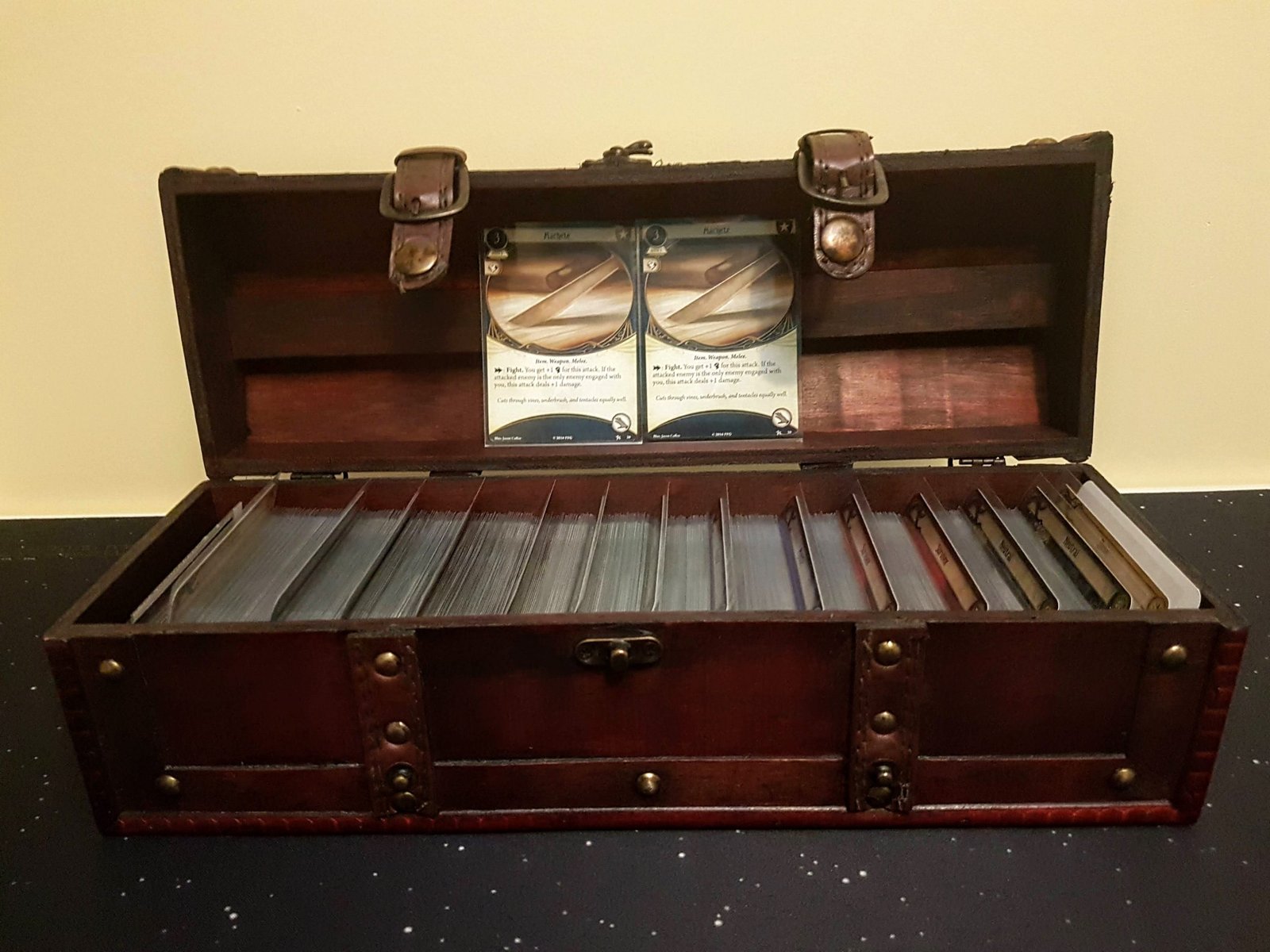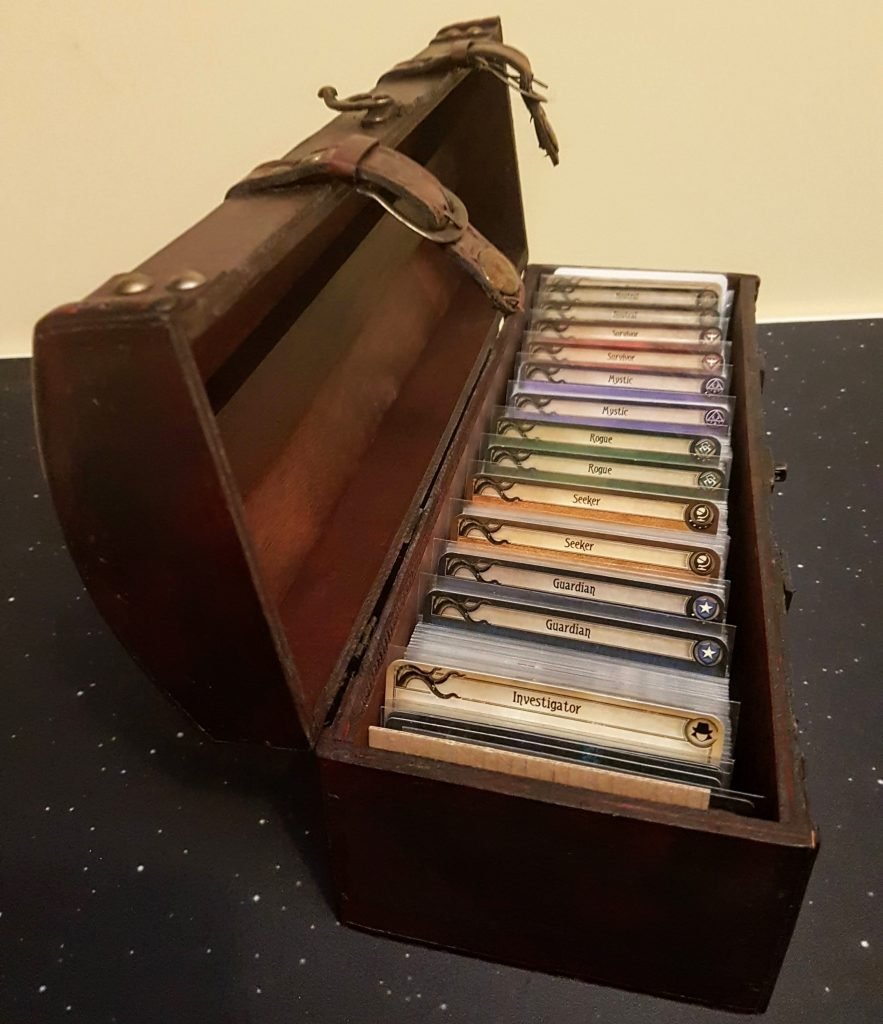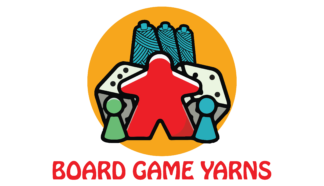
I tend to play solo games open-handed (bottom left/bottom right), so I can see what cards both investigators have at all times.
TLDR:
Playing AH:TCG two-handed is more fun. Two core sets make it even better.
Summary
This article explores why I now prefer to play AH:TCG two-handed and what buying an extra core set has brought to the table.
I’ve been playing Arkham Horror: The Card Game on and off for a few months now. I’ve played other tabletop games as well, but I keep returning to AH:TCG to delve further into the mythos and suffer terribly at the hands of cultists and monsters.
Having started naturally with the core set, I’ve also got the whole Dunwich cycle and recently had a couple of runs at the two scenarios in this deluxe expansion.
I’ve yet to play multiplayer, so all my playthroughs so far have been solo. I had been playing ‘true solo’ (i.e. as just one investigator) with mixed results. I’d made it out alive and sane(!) most of the time, but not with a resolution I would consider optimal. This lead me to consider if I should try two-handed (i.e. playing as two investigators at once).
Two is better than one
Well, I can immediately tell you that I wish I’d started playing two-handed a heck of a lot sooner. I think it’s much more fun! Not only do you get to simply do more each game, you get greater flexibility in your approach to each scenario (and in deck building).
I also think that the game scales really well from one to two investigators. You might think it’s more difficult because you draw one encounter card per investigator in the mythos phase (so you draw two instead of one), but that’s not necessarily the case:
- You still only add one doom token to the current agenda. (This does NOT scale up per investigator.)
- You do now draw two encounter cards, (one per investigator) but you now have two investigators to deal with them.
- If both your investigators were at the same location, that location might quickly become overwhelmed with negative encounter effects. However, your ‘gators can move independently, so if they’re on different locations, the negative effects of multiple encounters can be spread out.
- If you draw an encounter card with the ‘peril’ keyword, the negative effect usually must be dealt to the person who drew the card regardless of any other rules, so that doesn’t change between one and two-handed/player games.
Being able to scout two different locations at once is invaluable in some scenarios. When you’ve got to obtain a certain amount of clues to progress, you can double up the speed with which you identify locations that actually have clues. Yes – you’ll usually have to obtain more (for ‘per investigator’ clue counts), but being able to locate them quicker is great!
Also, having one investigator run interference while the other flies around, hoovering up clues is ace!
More Core/Moar Coar

So, now that I’m playing two-handed, I’ve also caved and bought that second core set. It still feels like a bit of a waste due to all the components you don’t need/use (more on that later), but having enough pairs of the investigator asset, event and skill cards to build two competent decks at once is suddenly of utmost importance. Yes, you can avoid overlap of faction-specific cards, but when you want two of each neutral skill card in each deck, another core is essential.
I got my second core set near-mint from ebay, so when it turned up, I counted all the components and thankfully everything was there. Then the reality of how much I’m simply not going to use from this set, er… set in.
Hopefully what I write below demystifies some of the ‘to second core set or not to second core set’ conundrum. But first…
A note on proxies
There is the cheaper alternative to purchasing a second core set and that’s using proxies i.e. copied or imitated versions of cards. If you’re happy to write on a piece of paper or photocopy/scan a card and stick it into a sleeve with a legit card back facing out, then you can save yourself a bunch of cash.
I’m a stickler for the real thing and there’s nothing quite like the look and feel of all your cards being the consistent. I also revel in making this game look as good as it possibly can for immersion purposes. I can only imagine that if I used proxies, I’d spot the difference before the card was in my hand. Or the card sleeve wouldn’t sit quite right or weigh or shuffle differently, meaning those moments where you have to discard a random card, isn’t so random any more.
The main factors to this will be how fussy you are and how much you can afford. The other consideration is whether you care about copyright. After all, every card in this game has ‘© xxxx FFG’ printed on them – where xxxx is the year of production. (I’m not going to get into the legalities here.)
Based on my sentiments in the rest of this article, whether you play with official cards or proxies, my opinion is that you will benefit from the extra copies of each card being available for deck-building. So let’s look in more detail at what your second core will bring to the party…
Break it down
A core set contains 239 cards and this is how it breaks down when using it as your second core:
- Investigator cards
- Cards one to five represent your chosen investigator, so no need for second copies unless terrible table spillage occurs or existing cards get damaged some other way.
- Investigator mini cards
- There are also five mini-cards used as investigator avatars. Again, you’ll never have more than one of each in play at any one time.
- Scenario cards
- These include: Scenario reference cards, Agenda cards, Act cards, Location cards, Enemy cards and Treachery cards. They make up a stonking 110 of the cards, so it hurts the most to see all of these also sidelined. Of course they’ll make good replacements if my originals get damaged.
- Some people have used their duplicate scenario cards to keep the core set scenarios pre-built, but this soon comes undone when you acquire Dunwich, which also re-uses your rats and other encounter sets from the core.
- Player cards
- Here’s where it actually becomes worthwhile getting a second core set. Read on for more info on these 119 cards. Not all of them make it out alive!
Player cards

As my collection grows, I’ll just buy another one of these and have half the classes in one, half in the other and so on until it’s one per class, no doubt!
The standard rule is that you can only have a maximum of two copies of any single player card in your deck. So with a single core set, you only have 50% of deck-building potential when it comes to faction-specific player cards. A second core doubles it by adding a second copy of the same card into your deck. Not only does this increase your chances of drawing that card, it also reduces your chances of drawing a rubbish, filler card that doesn’t synergise with the rest of your deck’s strategy. With a second core you can refine and streamline your deck building.
Player cards include:
- Player reference cards
- Two extra player reference cards might be handy in a 4-player game for inexperienced players, but once people are familiar with the game’s phases and available player actions, these can be left in the box.
- Asset cards
- Duplicate investigator-specific assets (e.g. Roland’s .38 Special) are of no use. You can only carry one per deck. There are 5 of these.
- Weakness cards
- Duplicate investigator-specific weaknesses (e.g. Cover Up) are also useless. You can only carry one per deck. There are 5 of these.
- You also only want to play with a single set of basic weaknesses, otherwise you the randomisation. There are 10 basic weaknesses.
- Skill cards
- Event cards
So what can be used from a second core is only: non investigator-specific Asset cards, all Skill cards and all Event cards. This totals 96 cards – way less than half the 239 contained in the box!
What’s the use?
So now we’ve established what we will actually be using, these player cards can be broken down into two further sub-sections:
- Faction-specific
- There are 70 of these. In the core set, you only get one copy of each faction-specific asset/skill/event card. That’s just one zero-experience ‘.45 Automatic‘ for example. The likelihood of you drawing that asset early on in your starting hand or even early in a game is pretty low. Having a second one in your deck, doubles your chances.
- Neutral
- There are 26 of these. When it comes to neutral asset cards, you have four ‘Knife‘ cards and four ‘Emergency Cache‘ cards, so you’re all set for building two simultaneous ‘gator decks.
- However, all the neutral skill cards like Manual Dexterity or Unexpected Courage, only come in pairs in a core set. So you’re OK if you have just one investigator deck to build, but if you’re building two, it’s a tough decision whether your Guardian or Survivor gets certain ones!
The sheer power it gives you by doubling up on some of the core player cards is awesome! I used to play true solo as Roland with only one core and I considered myself lucky to draw any of the weapons I put in there when I needed them. Now I can pretty reliably draw a decent weapon in my starting hand (remember that Mulligan!) or during the early game. I can’t wait to see what effect this has on replaying the core set scenarios as I’ve only tried it with the two Dunwich opening scenarios so far!
The dregs and leftovers

So if purchasing and then sidelining so many cards doesn’t quite hurt enough, you should also consider momentarily that you also don’t need a second copy of:
- The box and insert
- The game manuals
- The tokens
Still – it’s always good to have spares!
Until next time… game on!
Error: No feed found.
Please go to the Instagram Feed settings page to create a feed.
